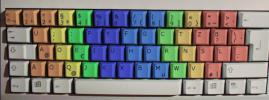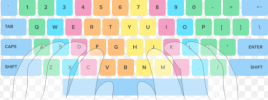Hey, I've been writing with a 10 finger system for a while now, and even back when I was learning I encountered different systems, not quite understanding the point.
It's about the number series above. Most pages (especially in the English language robbery) use the system on picture A. So the occupancy always runs diagonally. This makes the most sense to me and I have the feeling that it is the most ergonomic - because you already work diagonally without the entire lower area, so why should I change the system for the number row?
The second image shows the system that is often used on German pages. I think that the difference is due to the fact that the symbols in the ISO-De are located differently. But isn't it still very awkward and unnatural to suddenly move the fingers in the top row in the opposite direction?
Also, I have now seen sites in the US space that use the second system and I really don't know why that is done. The last picture (C) shows a system that I didn't even know until just now and makes the least sense to me.
I would be interested to know what you think is the most comfortable and if you know why there are these differences.
 = A
= A
 = B
= B
 = C
= C
It's about the number series above. Most pages (especially in the English language robbery) use the system on picture A. So the occupancy always runs diagonally. This makes the most sense to me and I have the feeling that it is the most ergonomic - because you already work diagonally without the entire lower area, so why should I change the system for the number row?
The second image shows the system that is often used on German pages. I think that the difference is due to the fact that the symbols in the ISO-De are located differently. But isn't it still very awkward and unnatural to suddenly move the fingers in the top row in the opposite direction?
Also, I have now seen sites in the US space that use the second system and I really don't know why that is done. The last picture (C) shows a system that I didn't even know until just now and makes the least sense to me.
I would be interested to know what you think is the most comfortable and if you know why there are these differences.
 = A
= A = B
= B = C
= C/cdn.vox-cdn.com/uploads/chorus_asset/file/13759031/DSCF8482_3.jpg)